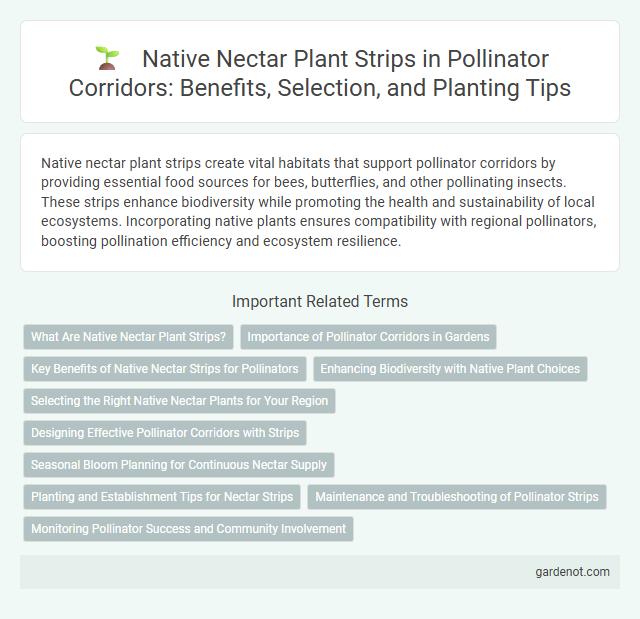Native nectar plant strips create vital habitats that support pollinator corridors by providing essential food sources for bees, butterflies, and other pollinating insects. These strips enhance biodiversity while promoting the health and sustainability of local ecosystems. Incorporating native plants ensures compatibility with regional pollinators, boosting pollination efficiency and ecosystem resilience.
What Are Native Nectar Plant Strips?
Native nectar plant strips are specially designed linear habitats featuring a diverse mix of indigenous flowering plants that provide essential nectar resources for pollinators like bees, butterflies, and hummingbirds. These strips support biodiversity by offering continuous, season-long nectar sources and breeding grounds, enhancing pollinator survival and ecosystem health. Strategically implemented along agricultural fields, roadsides, and urban areas, native nectar plant strips help establish pollinator corridors that improve pollination services and contribute to sustainable environmental management.
Importance of Pollinator Corridors in Gardens
Native nectar plant strips enhance pollinator corridors by providing essential food resources for bees, butterflies, and hummingbirds, supporting biodiversity and ecosystem health. These corridors facilitate safe movement and genetic exchange between pollinator populations, crucial for plant reproduction and crop pollination. Integrating native nectar plants into gardens strengthens resilience against habitat fragmentation and promotes sustainable urban ecosystems.
Key Benefits of Native Nectar Strips for Pollinators
Native nectar plant strips provide essential foraging resources for pollinators by offering a diverse and continuous supply of high-quality nectar throughout the growing season. These strips enhance habitat connectivity and support the health and reproduction of native bees, butterflies, and other pollinating insects. Planting native species ensures adaptation to local conditions, promoting resilience and sustainability in pollinator populations.
Enhancing Biodiversity with Native Plant Choices
Establishing a native nectar plant strip within a pollinator corridor significantly enhances biodiversity by providing vital foraging resources for indigenous pollinators such as bees, butterflies, and hummingbirds. Native plants offer optimal nectar quality and bloom timing that align with the life cycles of local pollinator species, promoting healthier and more resilient ecosystems. Integrating diverse native flora supports habitat connectivity and encourages the proliferation of native pollinator populations, contributing to sustained ecological balance.
Selecting the Right Native Nectar Plants for Your Region
Selecting the right native nectar plants for your region involves researching species that naturally thrive in local conditions and provide abundant nectar throughout the pollination season. Emphasizing native wildflowers like Echinacea, Asclepias, and Solidago promotes habitat suitability and supports native pollinators such as bees, butterflies, and hummingbirds. Incorporating a diverse mix of flowering plants with staggered bloom times ensures continuous nectar sources, enhancing pollinator corridor effectiveness.
Designing Effective Pollinator Corridors with Strips
Native nectar plant strips enhance the effectiveness of pollinator corridors by providing continuous, diverse floral resources tailored to local pollinators' needs. Selecting region-specific native plants ensures blooming periods overlap, supporting pollinator species such as bees, butterflies, and hummingbirds throughout the growing season. Strategic placement of these strips alongside agricultural or urban areas maximizes habitat connectivity, promoting pollinator movement and biodiversity.
Seasonal Bloom Planning for Continuous Nectar Supply
Native nectar plant strips designed with seasonal bloom planning ensure a continuous nectar supply critical for pollinator health and biodiversity. Incorporating a diverse range of native plants with staggered flowering periods supports various pollinators throughout spring, summer, and fall. Strategic selection of species like milkweed, coneflowers, and goldenrod maximizes nectar availability and strengthens pollinator corridors year-round.
Planting and Establishment Tips for Nectar Strips
Planting native nectar plant strips involves selecting diverse species that bloom sequentially to ensure continuous nectar sources for pollinators throughout the season. Prepare the soil by removing invasive species and incorporating organic matter to improve drainage and fertility, enhancing plant establishment. Regular monitoring and adaptive management, such as supplemental watering during dry periods and spot weeding, support robust growth and long-term sustainability of nectar strips within pollinator corridors.
Maintenance and Troubleshooting of Pollinator Strips
Regular maintenance of native nectar plant strips in pollinator corridors involves timely weeding, mulching, and monitoring for pest infestations to ensure robust plant health and continuous nectar availability. Troubleshooting common issues requires identifying invasive species encroachment, soil nutrient deficiencies, and signs of disease to implement targeted interventions such as selective herbicide application or soil amendments. Consistent observation and adaptive management practices optimize pollinator habitat quality and support diverse pollinator populations.
Monitoring Pollinator Success and Community Involvement
Native nectar plant strips are essential habitats that boost pollinator populations by providing continuous food sources throughout the growing season. Monitoring pollinator success involves regular surveys of species diversity, visitation rates, and reproductive outcomes to measure ecological impact accurately. Engaging local communities through citizen science initiatives and educational programs fosters stewardship and enhances data collection, ensuring long-term sustainability of pollinator corridors.
Native nectar plant strip Infographic

 gardenot.com
gardenot.com